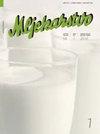Effects of starter culture and storage on volatile profiles and sensory characteristics of yogurt or cream butter
IF 1.1
4区 农林科学
Q3 AGRICULTURE, DAIRY & ANIMAL SCIENCE
引用次数: 6
Abstract
In this study volatile compounds and sensory properties of butter produced from cream or yogurt using Lactococcus lactis subsp. lactis biovar. diacetylactis or Leuconostoc mesenteroides subsp. cremoris as well as a mixture of these two bacteria were investigated over 60 days. A total of 10 esters, 6 aldehydes, 11 ketones, 16 alcohols, 6 acids, 2 sulphides, 3 terpenes, and 3 miscellaneous compounds were detected. There were more volatile compounds in cream butter than in yogurt butter. While S-methyl thioacetate was only found in yogurt butter samples, hexanal, ethanol, 2-nonanone, 2-pentanone, 2-heptanone, acetic, butanoic (butyric) and hexanoic acid were the most abundant volatiles in both cream and yogurt butter. The results showed that the use of starter in the manufacturing of yogurt butter, which is traditionally produced without starters, affected the volatile compounds and sensory properties. The highest general acceptability scores were given to the butter samples containing mixed cultures at the end of storage.发酵剂培养和贮存对酸奶或奶油黄油挥发性特征和感官特性的影响
在本研究中,使用乳酸乳球菌亚种从奶油或酸奶中生产的黄油的挥发性化合物和感官特性。乳酸生物变种。二乙酰凝集素或间质明串珠菌亚种。cremoris以及这两种细菌的混合物在60天内进行了研究。共检测到10种酯、6种醛、11种酮、16种醇、6种酸、2种硫化物、3种萜烯和3种杂合物。奶油黄油中的挥发性化合物比酸奶黄油中的多。硫代乙酸S-甲基酯仅在酸奶黄油样品中发现,己醛、乙醇、2-壬酮、2-戊酮、2-庚酮、乙酸、丁酸和己酸是奶油和酸奶黄油中最丰富的挥发物。结果表明,在传统上不使用发酵剂生产酸奶油的过程中,使用发酵剂会影响挥发性化合物和感官特性。在储存结束时,含有混合培养物的黄油样品的总体可接受性得分最高。
本文章由计算机程序翻译,如有差异,请以英文原文为准。
求助全文
约1分钟内获得全文
求助全文
来源期刊

Mljekarstvo
Agricultural and Biological Sciences-Animal Science and Zoology
CiteScore
1.90
自引率
41.70%
发文量
18
审稿时长
12 weeks
期刊介绍:
Mljekarstvo is an open access, peer-reviewed international quarterly scientific journal. The first issue was published in 1951, by the Croatian Dairy Operators'' Association (today: Croatian Dairy Union, publisher). In a paper at a Union conference held 28 October 1951 in Zagreb it was said: "Our desire is that this magazine does not meet the fate of its predecessors, but that it continues to reflect the creative efforts and to provide guidelines for the producers as well as all other operators employed in the dairy industry."
It is our pleasure today to say that wishes of the enthusiasts who attended the conference have come true, and the magazine Mljekarstvo during the last six decades was a reflection of the creative efforts of numerous dairy scientists and experts, and through its texts it served as a guideline in improving production and processing of milk and dairy products. Mljekarstvo has been following all the achievements of the dairy profession in Croatia, and it also gives the short surveys of world achievements. The result of the research of local and foreign scientists and experts always find their place in the magazine Mljekarstvo. It has been edited by our outstanding dairy experts employed at colleges, research institutions and dairy companies.
 求助内容:
求助内容: 应助结果提醒方式:
应助结果提醒方式:


